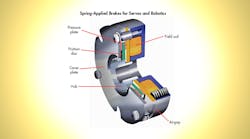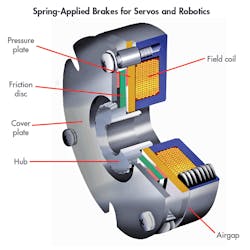This file type includes high resolution graphics and schematics when applicable.
As today’s equipment moves towards miniaturization, there is a call for smaller, lighter spring-applied brakes that deliver the same holding torque. Ogura’s MTNB/TNB series brakes answer that call. Whereas a traditional 2-Nm brake has a width of 30 mm, the newest thin series brake has the same torque at a width of only 10 mm. A special coil design allows for high torque in a smaller body.
How They Work: Spring-Applied Brakes for Servo Motors and Robotics
The fundamental purpose of a power off brake is to stop or hold a load. The most common are spring-applied brakes. When power is off or lost, the brake is engaged.
Power off condition: Coil is de-energized → The coil/field assembly is fixed and kept from rotating. The internal springs inside the brake forces the pressure plate up against a friction disc. The friction, created by squeezing the disc, keeps the shaft from rotating.
Power on condition: Coil is energized → The electric current causes the coil to become an electromagnet. Magnetic attraction pulls the pressure plate towards the coil; as it does, it compresses the springs creating an airgap between the pressure plate and friction disc. This allows the plate to move freely and the shaft to rotate.
These brakes will hold a load or provide for emergency stopping when power is released, or else lost to a servo motor. Some models have a manual release option. 24 V dc and 90 V dc are common, but other voltages are available. Designs can be as small as 18 mm in diameter, while larger designs are used on elevators and escalators. However, the most common applications are for robotic and servo motors for production, automation, and medical equipment.
This file type includes high resolution graphics and schematics when applicable.



